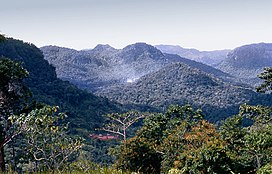Southeastern Papuan rain forests
| Southeastern Papuan rain forests | |
|---|---|
 | |
 Ecoregion territory (in purple) | |
| Ecology | |
| Realm | Australasian realm |
| Biome | tropical and subtropical moist broadleaf forests |
| Borders | Central Range montane rain forests, New Guinea mangroves, Northern New Guinea lowland rain and freshwater swamp forests, and Southern New Guinea lowland rain forests |
| Geography | |
| Area | 76,808 km2 (29,656 sq mi) |
| Countries | Papua New Guinea |
| Provinces | Central, Gulf, Milne Bay, Morobe, and Oro |
| Coordinates | 9°00′S 147°51′E / 9.0°S 147.85°ECoordinates: 9°00′S 147°51′E / 9.0°S 147.85°E |
| Conservation | |
| Conservation status | Relatively stable/intact |
| Protected | 830 km² (1%)[1] |
The Southeastern Papuan rain forests is a tropical moist forest ecoregion in southeastern New Guinea. The ecoregion covers the mountainous center and coastal lowlands of the Papuan Peninsula. [2] [3] [4]
Geography[]
The mountains that run the length of the peninsula are the eastern extension of the mountainous spine that runs the length of New Guinea. The Owen Stanley Range includes Mount Victoria (4,038 m), the ecoregion's highest peak .[5]
Climate[]
The climate of the ecoregion varies with altitude. The lowlands are humid and tropical. Average temperatures decrease with altitude, and the highest portions of the Owen Stanley Range experience regular freezing temperatures.[6]
Flora[]
The ecoregion's natural vegetation is humid evergreen rain forests. The forest types include alluvial rain forest on lowland plains, hill forests at the foot of the mountains, montane forests above 1000 meters, upper montane forests, and high mountain forests below the tree line. The highest peaks of the Owen Stanley Range are home to sub-alpine grasslands and shrublands, which are included in the separate Central Range sub-alpine grasslands ecoregion.[7]
Fauna[]
There are 138 species of mammals in the ecoregion, mostly marsupials, bats, and murid rodents. Seven mammal species are endemic: broad-striped dasyure (Paramurexia rothschildi), giant bandicoot (Peroryctes broadbenti), Papuan bandicoot (Microperoryctes papuensis), New Guinea big-eared bat (Pharotis imogene), Chiruromys lamia, Long-nosed mosaic-tailed rat (Melomys levipes), and Van Deusen's rat (Rattus vandeuseni).[8]
The ecoregion is home to 510 species of birds. The largest bird in the ecoregion is the flightless southern cassowary (Casuarius casuarius), which lives in the lowland forests.[9] Four species are endemic to the ecoregion – the brown-headed paradise kingfisher (Tanysiptera danae), grey-headed munia (Lonchura caniceps), streaked bowerbird (Amblyornis subalaris), and eastern parotia (Parotia helenae).[10]
Protected areas[]
A 2017 assessment found that 830 km², or 1%, of the ecoregion is in protected areas. Over 80% of the ecoregion is still forested.[11]
External links[]
- "Southeastern Papuan rain forests". Terrestrial Ecoregions. World Wildlife Fund.
References[]
- ^ Eric Dinerstein, David Olson, et al. (2017). An Ecoregion-Based Approach to Protecting Half the Terrestrial Realm, BioScience, Volume 67, Issue 6, June 2017, Pages 534–545; Supplemental material 2 table S1b. [1]
- ^ "Map of Ecoregions 2017". Resolve. Retrieved August 20, 2021.
- ^ "Southeastern Papuan rain forests". Digital Observatory for Protected Areas. Retrieved August 20, 2021.
- ^ "Southeastern Papuan rain forests". The Encyclopedia of Earth. Retrieved August 20, 2021.
- ^ Wikramanayake, Eric; Eric Dinerstein; Colby J. Loucks; et al. (2002). Terrestrial Ecoregions of the Indo-Pacific: a Conservation Assessment. Washington, DC: Island Press.
- ^ Wikramanayake, Eric; Eric Dinerstein; Colby J. Loucks; et al. (2002). Terrestrial Ecoregions of the Indo-Pacific: a Conservation Assessment. Washington, DC: Island Press.
- ^ "Southeastern Papuan rain forests". Terrestrial Ecoregions. World Wildlife Fund.
- ^ "Southeastern Papuan rain forests". Terrestrial Ecoregions. World Wildlife Fund.
- ^ BirdLife International. 2018. Casuarius casuarius. The IUCN Red List of Threatened Species 2018: e.T22678108A131902050. https://dx.doi.org/10.2305/IUCN.UK.2018-2.RLTS.T22678108A131902050.en. Downloaded on 09 June 2020.
- ^ "Southeastern Papuan rain forests". Terrestrial Ecoregions. World Wildlife Fund.
- ^ Eric Dinerstein, David Olson, et al. (2017). An Ecoregion-Based Approach to Protecting Half the Terrestrial Realm, BioScience, Volume 67, Issue 6, June 2017, Pages 534–545; Supplemental material 2 table S1b. [2]
- Australasian ecoregions
- Ecoregions of New Guinea
- Ecoregions of Papua New Guinea
- Montane forests
- Tropical and subtropical moist broadleaf forests
